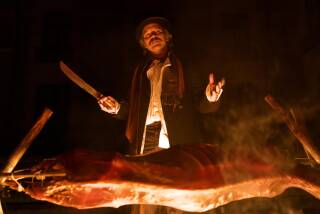‘How to Survive a Plague’ revisits the early days of AIDS epidemic
NEW YORK — In the 30 years that David France, director of the Oscar-nominated AIDS activism documentary “How to Survive a Plague,” has lived at the corner of 7th Street and Avenue C, the neighborhood has transformed dramatically.
During the worst years of the epidemic in the 1980s, death pervaded this far corner of the East Village. “It was inescapable. You would see people who were skinny, skinny skeletons trying to catch their breath, wheelchairs with men in their 20s, the KS [Kaposi’s sarcoma] lesions everywhere,” he recalls in his airy duplex apartment.
These days, the area is “supermodel central.”
A similar metamorphosis has taken place in his home, which contains “kind of an AIDS narrative” of its own, says France, 53. Though it looks like something out of the pages of an interior design magazine, the space has a harrowing history. France moved from the rundown building next door in 1988, after the family of a neighbor who died of AIDS offered him the apartment and all of its contents at a fire-sale price. Two more neighbors succumbed, and the home France and his husband, a television producer, now occupy is cobbled together from their tenements.
France’s biography seems inextricably tied to the life span of the disease in New York City. He moved to Manhattan from Kalamazoo, Mich., to pursue a doctorate in philosophy at the New School in June 1981, a few weeks before the first article about a “Rare Cancer Seen in 41 Homosexuals” appeared in the New York Times.
As the crisis intensified, France abandoned academia in favor of journalism. He wrote for the New York Native, one of the city’s early gay newspapers, before moving on to the Village Voice, Newsweek and the New York Times. He reported extensively about the scientific efforts to combat the virus, and also documented the work of ACT UP, the AIDS Coalition to Unleash Power, the activist group founded in 1987.
“It called upon you to do whatever you could do. Early on what I thought I could do was just ask questions and try to give the answers,” France says. He admits he was at least in part fueled by the desire to save his boyfriend, Doug Gould, who would eventually die from AIDS in 1992. Somehow, France himself never tested positive, a circumstance he describes as “strange and mysterious.”
The idea for a documentary was born in 2008, after he published a stunning piece in New York Magazine about Ramon Torres, a pioneering doctor who oversaw the AIDS program at St. Vincent’s Hospital in Greenwich Village, once the epicenter of the disease in the city. As the epidemic dramatically receded in the late ‘90s, thanks to new antiretrovirals, Torres developed a debilitating crystal meth habit, lost his practice and contracted HIV.
France found that Torres’ case was hardly an outlier — that many others struggled to find purpose after fighting such a dire threat for so long. In the gay community’s haste to put the dark days of the crisis behind it and embrace the new, more hopeful cause of same-sex marriage, the work of people like Torres had gone unrecognized.
Undaunted by his lack of filmmaking experience, France began the three-year process of compiling and editing thousands of hours of footage into “How to Survive a Plague,” financed through grants and private equity.
The film movingly chronicles the work of the ACT UP and its offshoot, the Treatment Action Group, whose headline-grabbing protests (including a giant inflatable condom draped over the home of North Carolina Sen. Jesse Helms) stirred flat-footed bureaucrats into action and helped fast-track effective treatments.
While box office returns for the film, now available for streaming on Netflix and Amazon Video, have been modest, the praise has been less sparing. It premiered at Sundance in 2012 to strong reviews and was named best first film by the New York Film Critics Circle. It found an unlikely booster in Ed Koch, the late New York City mayor and former ACT UP adversary who praised the “superb documentary” and suggested the group’s members deserve the Presidential Medal of Freedom.
It consists almost entirely of archival footage, with no narration and only a few, shrewdly edited minutes of contemporary interviews. The goal of the film, which France calls “a vérité found-footage documentary,” was to use the tools of cinema to transmit the urgency of the plague years to a new audience.
“I didn’t want to filter it through somebody’s memory. I didn’t want to put somebody in a chair, mike ‘em up, have them say, ‘It was a terrifying time.’ I wanted to see if I could find in that old footage, the terror,” he says.
It helped that the media-savvy members of ACT UP — or at least those who could afford camcorders, which became available commercially shortly after the outbreak of the virus — had generated “a huge pile of historically significant footage.”
France quickly settled on a protagonist: Peter Staley, a closeted, boyishly handsome Wall Street bond trader who quit his job to join ACT UP and became one of its most visible members. From there, it became a matter of finding enough footage of Staley to trace the broader story of the fight against HIV and AIDS.
In a potent decision, France waits until the closing minutes of the documentary to reveal that — spoiler alert — Staley, unlike so many of his contemporaries, survived. “It’s kind of brilliant because it’s how we felt. It was living a cliffhanger life where you didn’t know which of your friends was going to be around at the end of the year,” says Staley.
Although Staley was an eager participant, others were more reluctant to revisit the past. Many had, quite literally, sealed up their painful memories in boxes, leaving them untouched for 10 or 15 years.
In one case, France enlisted the grown daughter of Bob Rafsky, a late activist who features prominently in the film, to persuade a cinematographer to share his 90-hour archive. “She made this impassioned plea to him,” France recalls, tears welling in his eyes. “She had this belief that she could get to know him if she could see what was in those tapes.”
“How to Survive a Plague” has allowed Staley and other survivors to appreciate the positive things that emerged from the darkest days of the crisis. “We had forgotten how extraordinarily alive we were during those years and the beautiful things we did together,” says Staley, who founded the website AIDSMeds.com and served on the board of the American Foundation for AIDS Research. “I can’t impress upon people enough that yes, technically this is an AIDS documentary, but it’s ultimately a very uplifting story about being able to overcome incredible odds.”
More to Read
From the Oscars to the Emmys.
Get the Envelope newsletter for exclusive awards season coverage, behind-the-scenes stories from the Envelope podcast and columnist Glenn Whipp’s must-read analysis.
You may occasionally receive promotional content from the Los Angeles Times.










